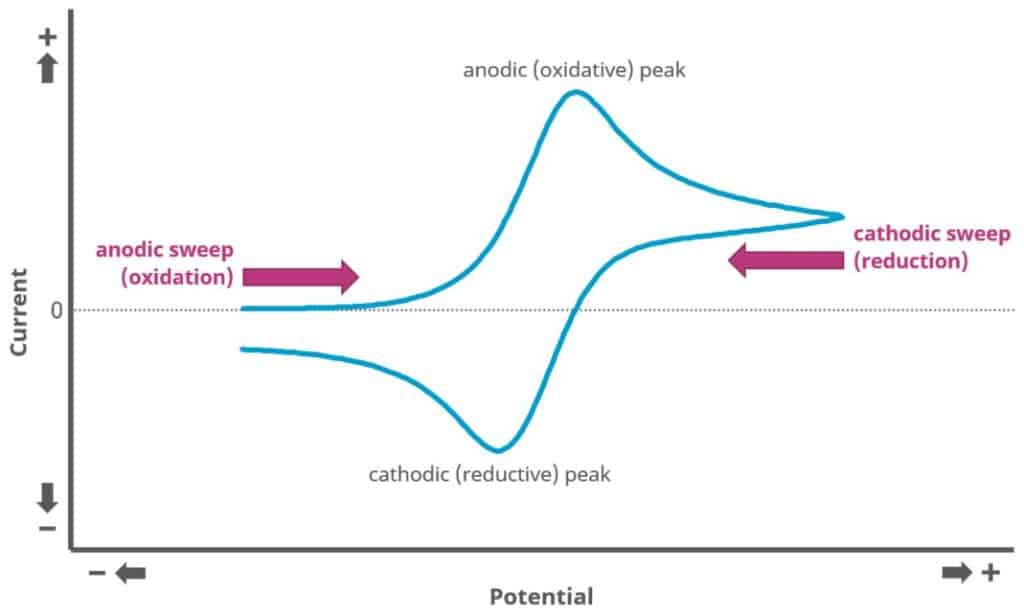Like any field of science and branch of chemistry, electrochemistry uses many acronyms, symbols, terms, and variables to describe physical phenomena. We use such terms as well in AfterMath Live. We strive to be clear in our presentation, but you may have your own preferences or learned using different symbols. Here, we will define and clarify our symbols, terminology, and variables used in AfterMath Live for electrochemical simulation. There are additional helpful documents you should review as you learn AfterMath Live.
Plotting Convention
By default, AfterMath Live plots data in the IUPAC convention (as does AfterMath from Pine Research). For a cyclic voltammogram, for example, data are presented as follows:

Terms, Symbols, and Variables
Throughout AfterMath Live for Electrochemical Simulation, you will encounter various symbols and terms representing important mechanistic variables. In the following table, you can learn the meaning of the symbols used in AfterMath Live and any important corresponding notes.
| Symbol | Meaning | Definition | Notes |
|---|---|---|---|
| E | electrochemical reaction | an electron transfer reaction | |
| C | chemical reaction | a chemical reaction involving no charge transfer | |
| E0 | standard potential | standard potential of an electrode or an electrochemical reaction couple | |
| k0 | standard heterogeneous rate constant | standard heterogeneous (electron transfer at the interface) rate constant of a reaction. It is the measure of the heterogeneous kinetic facility of a redox couple | |
| α | transfer coefficient | the measure of symmetry of the energy barrier for a single electron-transfer step (used in Butler-Volmer model of electrode kinetics) | α has a complementary function, which some refer to as ß, where ß = 1 – α. In AfterMath Live, we only use α as the input, designated for the cathodic reaction (αC). To the right of the α input, you will see αC= α and αA = 1- αC. These are calculated for you as a function of your input for α, merely to prevent any confusion as to how the software interprets the value of α entered. |
| D | diffusion coefficient | the rate at which a species moves under the influence of a gradience of chemical potential (i.e., concentration gradient) | |
| C* | bulk concentration | concentration of species in bulk solution | used to set the initial concentration of a species, before any electrolysis, in bulk solution. Before electrolysis, this is also the solution|electrode interface concentration. |
| k1 | forward reaction homogeneous rate constant | reciprocal values of the mean lifetime of a species, as a reaction proceeds in the forward direction | many symbols have been assigned to this element: kf, kb, kc, kox, ks, etc. In AfterMath Live, we do not wish to cause any confusion and have chosen k1 to simply mean the homogeneous rate constant in the forward direction (as written) |
| k-1 | reverse reaction homogeneous rate constant | reciprocal values of the mean lifetime of a species, as a reaction proceeds in the reverse direction | many symbols have been assigned to this element: kf, kb, kc, kox, ks, etc. In AfterMath Live, we do not wish to cause any confusion and have chosen k-1 to simply mean the homogeneous rate constant in the reverse direction (as written) |
| Keq | equilbrium rate constant | the ratio of forward and reverse rate constants at equilibrium | this value is calculated for quasi-reversible chemical reactions. It is not defined for irreversible reactions. For fully reversible reactions, only this value (and not forward and backward rates) is provided. |
Reaction Arrows
When adding reactions to your mechanism in AfterMath Live Electrochemical Simulation, users will have the choice of reaction arrow. Each arrow, for each E or C reaction, has different meaning and will require different input based on the choice of arrows. AfterMath Live uses explicit boundary conditions in the simulation engine based on arrow selection, unlike other software that treats all reactions as quasireversible reactions.
| Arrow | Reaction Type | Description | Required Parameter(s) |
|---|---|---|---|
| E | Fully reversible electrochemical reaction | No heterogeneous rate parameter required, fully reversible boundary conditions employed | |
| E | Quasi-Reversible electrochemical reaction | k0 – heterogeneous rate constant | |
| E | Irreversible electrochemical reaction | k0 – heterogeneous rate constant | |
| C | Fully reversible chemical reaction | Keq – equilibrium rate constant | |
| C | Quasi-Reversible chemical reaction | k1 – homogeneous rate constant for the forward reaction; and k-1 – homogeneous rate for the reverse reaction | |
| C | Irreversible chemical reaction | k1 – homogeneous rate constant for the forward reaction |